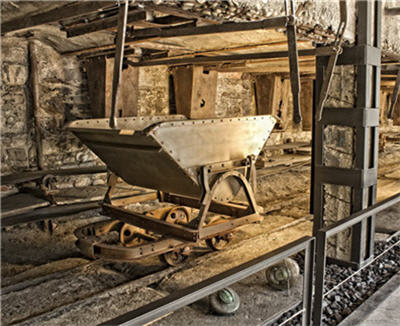$85 billion in write-offs may fuel small gold mining stocks

‘Dis-aggregation,’ where mines become dispersed among more players, may lead to much greater efficiency in the mining sector.
Miners’ big endeavor in the boom years was to produce more and more tons. Commodity prices were rising, so their revenues grew as they ramped up production.
The market rewarded the biggest players for taking over smaller counterparts, believing that it would mean even more production and lower overall costs.
Mergers and acquisitions proliferated. Fast forward to today. Commodity prices have declined and big miners are paying for their excesses.
A recent Citi report puts the total amount of write-offs at 90% of the value of projects that miners acquired after 2007.1
That’s US$85 billion in shareholder value gone.
Most of that destruction happened in the big industrial commodities like aluminum, coal, and iron ore.
But gold mining also saw its share of losses among the major gold miners, including Goldcorp, Barrick Gold and Kinross.
The Financial Post reports on one example2:
Cerro Negro was a [big] problem. Goldcorp spent $3.6 billion to buy the project in 2010, when gold prices were steadily going up. The company then ran into troubles with runaway inflation in Argentina, a permitting delay and government currency controls that limit the ability to convert Argentine pesos into U.S. dollars. All these factors drove up costs at Cerro Negro and meant a writedown was required to bring its carrying value down to reality.
Goldcorp also took a $2 billion write-down on the Penasquito mine in Mexico.
Big Miners Shedding Mines
During a recent visit to Barrick Gold, one of the world’s biggest gold producers, I learned that Barrick was planning to sell billions in assets within the year.
The company has written off a lot of its projects. But the debt they incurred to run the business is still there. They need to pay it off to avoid disaster, so they’re undoing the very thing that turned them into the behemoth gold producer they are today.
They’re selling off a number of their mines to other miners. For instance, they recently sold the Cowal mine to Evolution Mining for $US550 million.3
Smaller Players Stepping Up
Klondex Mines, the second company to show me around their mines, was breathing new life thanks to the majors’ difficulties.
The company was able to acquire a new producing mine from major gold producer Newmont Mining.
Newmont, once headed by Pierre Lassonde, wanted the cash without the hassle of running a small mine. Like Barrick, Newmont had too many small mines for its taste and was looking to shed assets like its Midas gold mine.
As the Klondex team explained during my recent trip, they think there is a lot more that they can do with their new mine than Newmont had anticipated.
The majors, meanwhile, are able to focus once again on their most important projects.
As one senior manager at Barrick put it, the company “allowed themselves to become fat” with people and unnecessary expenses during the bull market.
Now, they are cutting back heavily on those costs by reducing their staff and seeking ways to minimize costs.
Both Klondex and Barrick Gold cited maximizing their efficiency and getting their operations to run smoothly – without negative surprises like cost overruns – as their top priorities.
This includes dropping some of their smaller projects to raise some cash and pay off debt.
We are seeing a reversal of the M&A frenzy that occurred from approximately 2007 to 2011. The sector is becoming less consolidated and allowing room for new players.
The gold rout is showing why uncontrolled M&A was so bad for the mining sector.
During the M&A boom, majors used their best projects to subsidize a disorderly expansion. This diverted attention from generating production as cost-effectively as possible and lessened their attention to operational performance.
In the end, projects were heaped on the balance sheets of a few big players, who could not manage them appropriately.
Now the trend may be reversing. Projects are being re-distributed among more players, and smaller companies are getting a chance to grow.
Steve Todoruk has recently written about how some of these smaller groups are faring. Click here to read more.
By Henry Bonner (hbonner@sprottglobal.com)
Read online >
P.S.: An upcoming video will feature my trip to Northern Nevada, replete with actual mine footage and commentary. Watch for these on our Youtube channel (so make sure you subscribe).
1 http://www.afr.com/business/mining/miners-ma-sinks-in-sea-of-dud-deals-20150623-ghurp6
3 http://www.barrick.com/investors/news/news-details/2015/Barrick-Announces-Agreement-to-Divest-Cowal/
This information is for information purposes only and is not intended to be an offer or solicitation for the sale of any financial product or service or a recommendation or determination by Sprott Global Resource Investments Ltd. that any investment strategy is suitable for a specific investor. Investors should seek financial advice regarding the suitability of any investment strategy based on the objectives of the investor, financial situation, investment horizon, and their particular needs. This information is not intended to provide financial, tax, legal, accounting or other professional advice since such advice always requires consideration of individual circumstances. The products discussed herein are not insured by the FDIC or any other governmental agency, are subject to risks, including a possible loss of the principal amount invested.
Generally, natural resources investments are more volatile on a daily basis and have higher headline risk than other sectors as they tend to be more sensitive to economic data, political and regulatory events as well as underlying commodity prices. Natural resource investments are influenced by the price of underlying commodities like oil, gas, metals, coal, etc.; several of which trade on various exchanges and have price fluctuations based on short-term dynamics partly driven by demand/supply and nowadays also by investment flows. Natural resource investments tend to react more sensitively to global events and economic data than other sectors, whether it is a natural disaster like an earthquake, political upheaval in the Middle East or release of employment data in the U.S. Low priced securities can be very risky and may result in the loss of part or all of your investment. Because of significant volatility, large dealer spreads and very limited market liquidity, typically you will not be able to sell a low priced security immediately back to the dealer at the same price it sold the stock to you. In some cases, the stock may fall quickly in value. Investing in foreign markets may entail greater risks than those normally associated with domestic markets, such as political, currency, economic and market risks. You should carefully consider whether trading in low priced and international securities is suitable for you in light of your circumstances and financial resources. Past performance is no guarantee of future returns. Sprott Global, entities that it controls, family, friends, employees, associates, and others may hold positions in the securities it recommends to clients, and may sell the same at any time.
{{ commodity.name }}
{{ post.title }}
{{ post.date }}

Comments